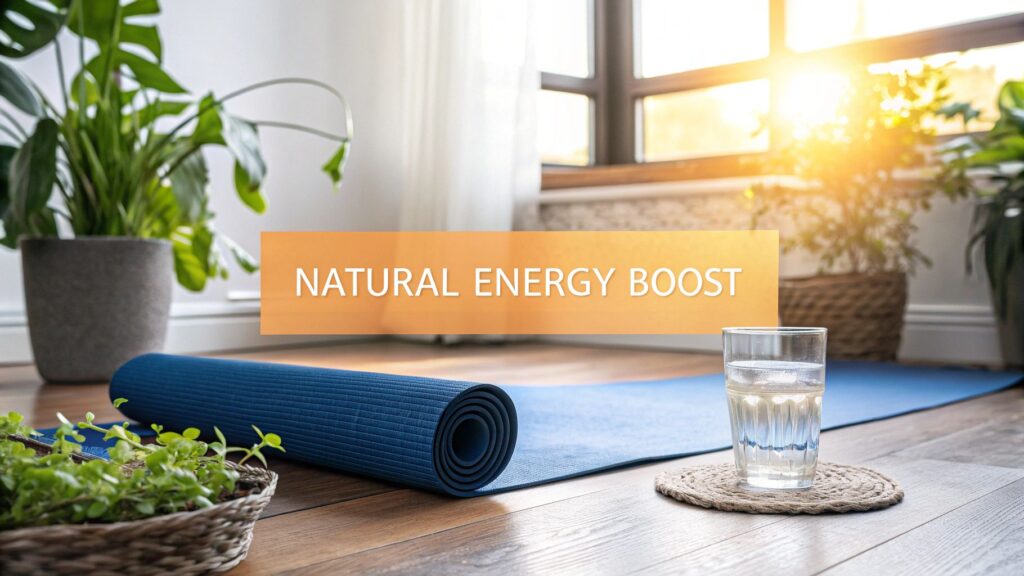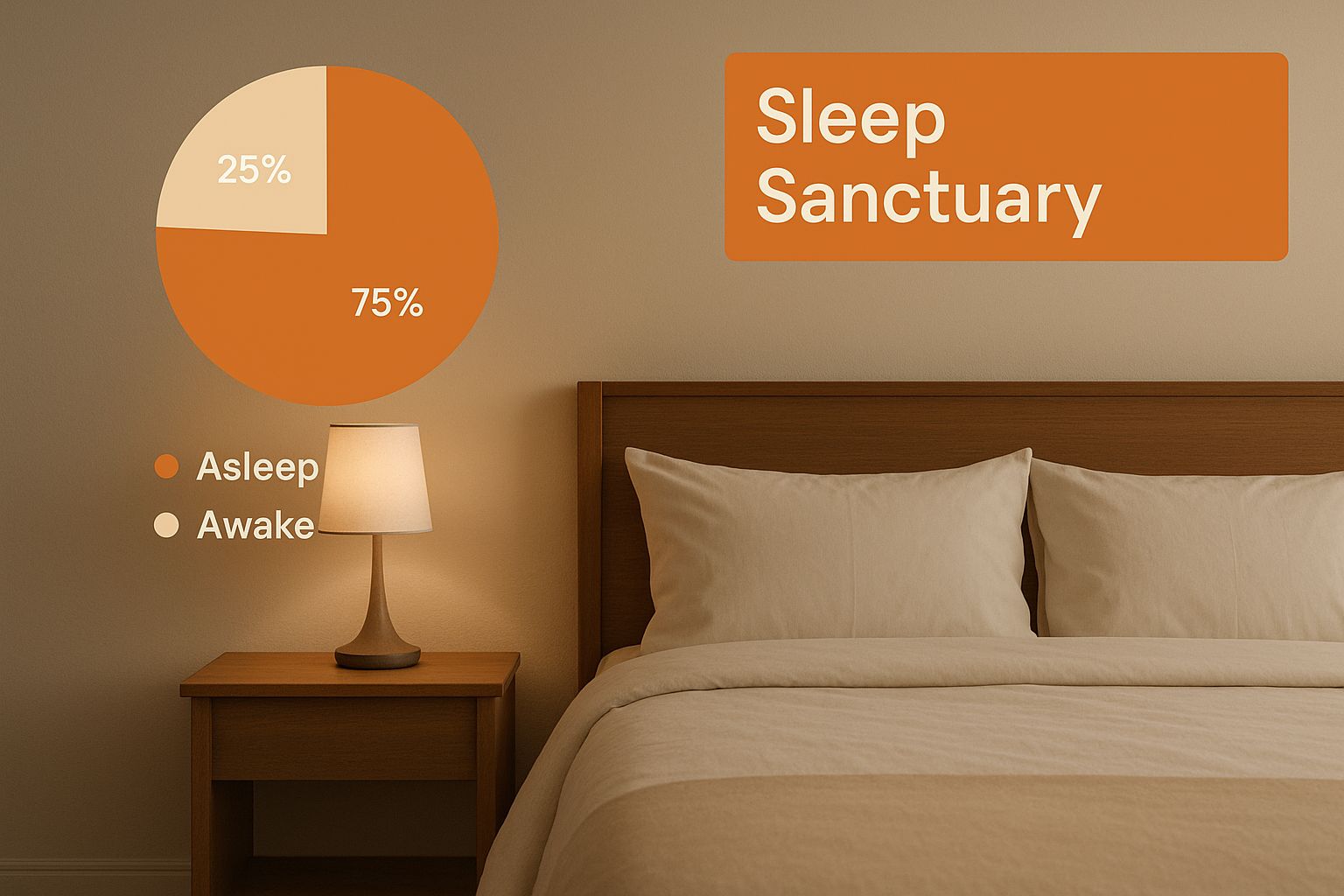How to Increase Energy Levels Naturally: Easy Tips & Tricks

If you're trying to figure out how to increase energy levels naturally, it all comes back to one simple, yet overlooked, foundation: sleep. While we all know diet and exercise are important, high-quality rest is the non-negotiable starting point that recharges your mind and body on a cellular level. Without it, every other effort is an uphill battle.
Your Foundation for All-Day Energy: The Power of Sleep
That feeling of being constantly drained, foggy, and irritable? It almost always starts the night before. Sleep isn't just about switching off. It's an active period of restoration where your body repairs tissues, locks in memories, and regulates the hormones essential for energy, like cortisol. When sleep quality takes a hit, your entire system pays the price the next day.
This is about more than just hitting the generic "eight hours" target. The real focus should be on the quality of those hours. Deep, restorative sleep is where the magic happens, and a lot of modern habits sabotage this process without us even realizing it. The goal here is to transform your sleep from a necessary chore into a powerful tool for building sustainable, all-day energy.
Crafting Your Ideal Sleep Environment
Your bedroom should be a sanctuary for rest, not a multi-purpose room for work, Netflix, and late-night scrolling. The environment you sleep in sends powerful signals to your brain, either promoting relaxation or stimulating alertness. Making just a few strategic adjustments can dramatically improve your ability to fall asleep faster and stay asleep longer.
Start by dialing in the three key factors of your sleep space: light, temperature, and sound.
- Darkness is non-negotiable. Even tiny amounts of light from electronics or streetlamps can disrupt the production of melatonin, the hormone that governs your sleep-wake cycle. Invest in some good blackout curtains, cover up those pesky LED lights on your devices, or just grab a comfortable sleep mask.
- Keep it cool. Your body temperature naturally needs to drop to initiate sleep. Most experts I've worked with recommend a room temperature somewhere between 60 and 67 degrees Fahrenheit (15 to 19 degrees Celsius) for truly optimal rest. A room that's too warm will almost guarantee restlessness and frequent waking.
- Minimize noise. Unpredictable sounds can easily pull you out of deep sleep. If you live in a noisy area, a white noise machine, a simple fan, or even earplugs can create a consistent and peaceful auditory backdrop that drowns out disturbances.
This infographic really drives home the key elements of creating a "Sleep Sanctuary" to improve your rest.

Thinking of your bedroom as a space dedicated only to tranquility helps reinforce the habits you need for restorative sleep.
The Power of a Pre-Sleep Routine
Just like you warm up before a workout, your brain needs time to wind down before sleep. A consistent pre-sleep routine acts as a powerful signal that it's time to transition from the stress of the day to a state of rest. This isn't about adding a bunch of complex tasks to your evening; it's about creating simple, repeatable rituals that work for you.
Your pre-sleep routine is the bridge between a busy, alert day and a night of deep, restorative rest. Consistency here is more important than complexity.
Try incorporating activities that calm your nervous system. This could be reading a physical book (not on a screen!), doing some gentle stretching, or taking a warm bath. It's absolutely crucial to avoid stimulating activities like checking work emails or scrolling through social media for at least an hour before bed. The blue light from screens is particularly disruptive to melatonin production, essentially tricking your brain into thinking it's still daytime.
Harnessing Your Circadian Rhythm
Your body’s internal 24-hour clock, known as your circadian rhythm, dictates your energy patterns. Aligning your daily habits with this natural rhythm is one of the most fundamental things you can do for stable energy. One of the most effective ways to do this is by managing your light exposure.
Getting natural sunlight in the morning is a total game-changer. It signals your internal clock to be alert and active, while also setting you up for better sleep later that night. The science backs this up: getting just 15–30 minutes of sun exposure shortly after waking helps regulate the release of cortisol in the morning (for energy) and melatonin at night (for sleep). This simple habit can optimize your energy balance throughout the entire day. You can learn more about the science of natural energy boosts at signos.com.
By working with your body's natural clock instead of against it, you can unlock a more consistent and reliable source of vitality.
Fueling Your Body for Sustained Vitality
What you put on your plate translates directly into how you feel all day long. Think of your body as a high-performance engine; it needs premium fuel to run efficiently. This is all about using nutrition to build stable, lasting energy, helping you sidestep those frustrating crashes that have you reaching for another coffee by 3 PM.
The food you eat provides the raw materials for adenosine triphosphate (ATP), which is the actual energy currency your cells spend. The secret to boosting your energy naturally is giving your body a steady supply of these materials, which stops the blood sugar rollercoaster so many of us are on thanks to processed foods and sugary snacks.

The Macronutrient Balancing Act
All-day energy isn't about cutting out entire food groups. It’s about strategically balancing your macronutrients—carbohydrates, proteins, and fats—at every single meal. Each one has a distinct job in fueling your body, and when they work together, the result is consistent vitality.
A diet loaded with simple carbs (like white bread, pastries, and sugary drinks) is a recipe for disaster. It causes a massive spike in blood sugar, followed by an equally dramatic crash that leaves you feeling sluggish, irritable, and craving even more sugar. The fix is to choose smarter fuel sources.
For instance, a cornerstone of boosting energy is optimizing your diet with nutrient-dense foods. Foods rich in protein, healthy fats, and complex carbohydrates are known to prevent those dramatic blood sugar swings. Natural yogurt gives you a great mix of protein and fats, while sweet potatoes offer high-fiber carbs that slow down absorption for longer-lasting energy. You can discover more insights about energy-boosting foods on Medical News Today.
Building an Energy-Focused Plate
Let’s get practical. Building a meal for sustained energy is a lot simpler than it sounds. The goal is to combine these three macronutrients in a way that promotes a slow, steady release of energy.
- Complex Carbohydrates: These are your main fuel, but quality is everything. Go for options high in fiber, like quinoa, brown rice, oats, sweet potatoes, and whole-grain bread. The fiber slows digestion, ensuring a gradual release of glucose into your bloodstream.
- Lean Proteins: Protein is key for building and repairing tissues, but it's also a powerhouse for energy by keeping you full and stabilizing blood sugar. Good sources include chicken breast, fish, tofu, beans, and lentils.
- Healthy Fats: Fats are a dense, long-lasting energy source. They also slow down how quickly you absorb carbs, which is another layer of defense against energy crashes. Bring in avocados, nuts, seeds, and olive oil.
A perfect real-world example of this is pairing an apple (a simple carb) with a spoonful of almond butter (protein and fat). On its own, the apple might cause a small sugar spike. But with the almond butter, the fat and protein slow everything down, giving you a smooth, sustained energy lift.
The secret to all-day energy isn't some "magic" food; it's the powerful synergy you create when you combine complex carbs, lean protein, and healthy fats in the same meal.
Choosing the right foods can feel overwhelming, but it's simpler when you see the direct comparison. Here's a quick guide to what builds you up versus what breaks you down.
Energy-Boosting Foods vs Energy-Draining Foods
| Nutrient Category | Choose These (Sustained Energy) | Limit These (Energy Crash) |
|---|---|---|
| Carbohydrates | Quinoa, oats, brown rice, sweet potatoes, whole-grain bread, vegetables | White bread, pastries, sugary cereals, candy, soda |
| Proteins | Chicken breast, fish (salmon, tuna), tofu, lentils, beans, eggs | Fried meats, processed deli meats, high-fat sausages |
| Fats | Avocado, nuts (almonds, walnuts), seeds (chia, flax), olive oil | Trans fats (in fried foods, baked goods), excessive saturated fats |
| Snacks | Apple with almond butter, Greek yogurt with berries, handful of nuts | Potato chips, cookies, granola bars with high sugar, energy drinks |
Making these smart swaps is one of the most effective ways to take control of your daily energy levels and avoid that afternoon slump for good.
Hydration: The Overlooked Energy Source
You can have the most perfect diet on the planet, but if you're even a little dehydrated, your energy levels will tank. Water is essential for nearly every metabolic process in your body, including energy production. When you're dehydrated, your heart has to work harder to pump blood, which leads straight to fatigue and brain fog.
Don't wait until you're thirsty to drink—thirst is actually a sign you're already behind. Keep a water bottle with you and sip on it consistently throughout the day. If you find plain water boring, infuse it with lemon, cucumber, or mint to make it more appealing.
Nourishing Your Cellular Powerhouses
At the very core of your energy production are your mitochondria, the tiny powerhouses inside your cells that turn nutrients into ATP. The foods you eat can either help or hinder how well they work. Nutrient-dense whole foods provide the vitamins and minerals your mitochondria need to thrive.
Foods that are especially good for mitochondrial health and energy include:
- Leafy Greens: Spinach, kale, and Swiss chard are loaded with magnesium, a mineral that is vital for producing ATP.
- Fatty Fish: Salmon, mackerel, and sardines are rich in omega-3 fatty acids, which support healthy cell membranes, and CoQ10, a compound essential for generating energy.
- Nuts and Seeds: Almonds, walnuts, and chia seeds offer a fantastic mix of healthy fats, protein, and fiber.
By focusing on these nutrient-rich options, you're not just filling your stomach—you're directly fueling the microscopic engines that power your entire body. The result is a more profound and lasting sense of vitality.
Movement That Creates More Energy, Not Less

It’s one of the great paradoxes of human energy: you have to spend a little to make a lot more. When you’re feeling completely wiped out, the absolute last thing your brain wants you to do is get up and move. But physical activity is one of the most reliable ways to pull yourself out of a slump and combat that nagging, persistent fatigue.
The trick is to reframe how you think about exercise. It’s not a chore designed to drain your last reserves; it’s a biological switch that signals your body to start creating more energy at a cellular level. Think of it as a long-term investment in your vitality—one that pays incredible dividends once you get past that initial resistance.
The Science Behind Energizing Exercise
When you get your body moving, you kick off a cascade of physiological changes that directly ramp up your energy production. One of the biggest things happens inside your cells. Exercise literally tells your body to grow new mitochondria, the tiny power plants in your cells responsible for turning food and oxygen into usable energy (ATP).
More mitochondria mean your body gets way more efficient at creating fuel, leading to higher overall energy reserves day in and day out. Regular movement also tunes up your entire cardiovascular system. Your heart learns to pump more blood with each beat, and your body builds more capillaries, improving oxygen delivery to your muscles and brain. That boost in oxygen flow is a game-changer for reducing fatigue and sharpening your mental focus.
Finding Your Energy-Boosting Movement Style
Here’s the thing: the best exercise for energy is the one you'll actually stick with. There is no magic, one-size-fits-all workout. A balanced approach that mixes different types of movement is usually the most effective strategy. The goal is to find activities you genuinely enjoy so they become a sustainable part of your life, not another box to check.
Here are a few types of movement that are particularly great for boosting vitality:
- Brisk Walking: This is probably the most accessible form of energizing exercise out there. A quick 20-30 minute walk, especially if you can do it outdoors, can significantly improve your mood, get your blood flowing, and give you a gentle energy lift without overdoing it.
- Yoga and Tai Chi: These mind-body practices are fantastic for increasing energy by tackling stress head-on. They combine gentle movements, stretching, and deep breathing to calm your nervous system, which helps fight the draining effects of the stress hormone cortisol.
- Strength Training: Lifting weights or doing bodyweight exercises like squats and push-ups builds lean muscle. Because muscle is more metabolically active than fat, having more of it boosts your resting metabolic rate. That means you burn more calories—and generate more energy—even when you're sitting still.
- Aerobic Exercise: Activities like jogging, cycling, or swimming are incredible for your heart and lungs. Consistent aerobic exercise makes everyday tasks feel less strenuous, leaving you with more energy in the tank for everything else.
Starting small is the key. Experts suggest aiming for at least 150 minutes of moderate-intensity aerobic activity per week to really boost your energy. This kind of movement stimulates the production of adenosine triphosphate (ATP), the molecule that transports energy within your cells, leading to better muscle mass and stamina. Even just 20 minutes of low-to-moderate activity three times a week can elevate energy by increasing key neurotransmitters like dopamine and serotonin. You can discover more insights about natural ways to boost energy at Harvard Health.
Overcoming the Initial Fatigue Barrier
Let's be honest, the hardest part is just getting started. When you're already exhausted, lacing up your shoes can feel like climbing a mountain. This is where a smart, strategic approach makes all the difference.
"The secret to getting ahead is getting started. The secret of getting started is breaking your complex overwhelming tasks into small manageable tasks, and then starting on the first one." – Mark Twain
This wisdom is perfect for exercise. Don't tell yourself you have to go run a 5k on day one. Instead, commit to something almost laughably easy, like a 10-minute walk around the block. That small, initial win is what builds momentum.
Here are a few practical tips to get over that hump:
- Start Small and Build Slowly: A short walk is infinitely better than no walk. Begin with just 10-15 minutes of movement each day, then gradually increase the duration and intensity as your energy improves.
- Schedule It In: Treat your movement time like an important meeting you can't miss. Block it off in your calendar to protect that time and make it a non-negotiable part of your day.
- Find an Accountability Partner: Teaming up with a friend can be the secret sauce for motivation. Knowing someone is counting on you makes it much harder to bail on a planned session.
- Listen to Your Body: Some days you'll feel ready to go, and other days you won't. On low-energy days, opt for something gentle like stretching or a slow walk instead of forcing a high-intensity workout. Honoring your body’s signals is how you prevent burnout.
By weaving consistent movement into your routine, you are effectively teaching your body to become a more efficient energy-producing machine. For those looking to take their physical performance even further, our guide on how to improve stamina naturally is a great next step. That initial push will soon be rewarded with a lasting increase in vitality that powers you through your entire day.
Managing Stress to Reclaim Your Energy
Chronic stress is the silent thief of vitality. It acts like a slow, invisible leak in your energy tank, steadily draining your physical and mental reserves until you’re left completely running on empty.
When your body is stuck in a constant state of "fight or flight," it hijacks precious resources, diverting them away from normal functions to deal with what it perceives as an endless threat.
The main culprit behind this is cortisol, the body's primary stress hormone. While it's incredibly useful in short, intense bursts, chronically high cortisol levels wreak havoc on your entire system. It messes with your sleep, impairs digestion, weakens your immune response, and eventually leads to that profound exhaustion we call burnout.
Learning to manage stress isn't just a mental health nice-to-have; it's a non-negotiable strategy for anyone serious about boosting their energy for the long haul.
Calming Your Nervous System in Minutes
One of the most powerful things you can do to fight back against stress is to intentionally activate your body's relaxation response. The good news? You don't need a spa day or a week-long vacation to do it. You can start right now, wherever you are, with simple breathing exercises.
These techniques work by directly stimulating the vagus nerve, which acts like a switch to shift your nervous system from a stressed-out state to a calm, restorative one.
A remarkably effective and easy method I often recommend is Box Breathing:
- Inhale Slowly: Breathe in through your nose for a count of four.
- Hold Your Breath: Gently hold your breath at the top for a count of four.
- Exhale Slowly: Breathe out through your mouth for a count of four.
- Hold Again: Hold your breath at the end of the exhale for another count of four.
Just repeat this cycle for two or three minutes. The rhythmic, predictable pattern helps lower your heart rate, dials down cortisol production, and brings an almost immediate sense of calm. It’s an incredibly practical tool you can pull out before a tough meeting, while stuck in traffic, or any other time you feel that wave of overwhelm start to build.
The Rejuvenating Power of Nature and Hobbies
Another potent antidote to chronic stress is to make a conscious effort to disconnect from your daily grind. Spending time in nature, sometimes called "ecotherapy," has been shown to significantly lower cortisol and reduce the mental fatigue that drains your energy.
Even a quick 20-minute walk in a local park can make a measurable difference. The trick is to fully engage your senses—feel the breeze on your skin, listen to the birds, and notice the different shades of green in the trees. This simple act of mindfulness anchors you in the present, pulling your focus away from anxious thoughts.
Engaging in hobbies and activities that bring you genuine joy is not an indulgence; it's a critical component of stress management and energy preservation.
Making time for hobbies is just as essential. Whether it's painting, gardening, playing an instrument, or tinkering on a project, these activities give you a much-needed mental break and a sense of accomplishment outside of your day-to-day responsibilities. They fill your cup back up, leaving you with more emotional and mental bandwidth to handle life's challenges.
Setting Boundaries to Protect Your Energy
A huge source of modern stress is the feeling of being constantly "on" and available to everyone. If you can't set clear boundaries at work and in your personal life, you're on a fast track to burnout. Protecting your time and energy isn't selfish—it's a critical act of self-preservation.
Start by figuring out where your energy is leaking.
- Are you constantly saying "yes" to things you don't have the time or energy for?
- Do you find yourself checking work emails late into the evening or on weekends?
- Are there relationships in your life that consistently leave you feeling more drained than fulfilled?
Learning to politely say "no" or delegate tasks is a skill that directly protects your energy reserves. You can start small by setting a firm cutoff time for work communications each day. This one simple boundary creates the mental space you need to properly rest and recharge your batteries.
By actively managing your stressors, you plug the leaks in your energy tank and save your power for what truly matters.
Of course. Here is the rewritten section, crafted to sound completely human-written and natural, following the expert tone and style of the provided examples.
Strategic Supplements and Hydration for an Extra Boost
Getting your sleep, nutrition, and exercise dialed in is the foundation of high energy. But let's be real—sometimes your body just needs more targeted support. This is where a few smart supplements and a serious focus on hydration can give you that extra edge, helping you fill in specific gaps and fine-tune your cellular energy production.
The key is to think of them as enhancements, not replacements for a healthy lifestyle.
Before you start popping new pills, I always recommend talking to a healthcare professional. They can run tests to see if you have any actual deficiencies and make sure you're choosing what’s right for your unique biology. This takes the guesswork out of the equation and ensures you’re hitting the real root cause of your fatigue.
Targeting Common Energy-Draining Deficiencies
If you're dealing with a deep, persistent fatigue that lifestyle tweaks just aren't fixing, an underlying nutrient deficiency might be the culprit. I've seen it time and again. Two of the most common offenders are iron and vitamin B12—both are absolute workhorses in how your body creates and moves energy. Getting these levels checked is a smart first move.
-
Iron: This mineral is a core component of hemoglobin, the protein in your red blood cells that ferries oxygen from your lungs to literally everywhere else. When your iron is low, your cells are starved for oxygen, which leads directly to that classic feeling of weakness and exhaustion.
-
Vitamin B12: Absolutely essential for building healthy red blood cells and turning the food you eat into usable glucose. A B12 deficiency can trigger a specific kind of anemia that leaves you feeling wiped out and mentally foggy.
If tests confirm a deficiency, working with your doctor on a targeted supplement plan can be a total game-changer. For a deeper dive into this, you can learn more about specific vitamins for energy and focus and how they all work together.
Advanced Support for Cellular Energy
Beyond correcting the basics, some compounds can help optimize your body's energy-producing machinery right at the cellular level. Think of these supplements as support for your mitochondria—the tiny powerhouses inside your cells—helping them run more efficiently.
Coenzyme Q10 (CoQ10) is a powerful antioxidant your body makes on its own, and it's vital for creating ATP, your body's main energy currency. Our natural production of CoQ10 tends to drop as we age, which can contribute to that feeling of slowing down. Supplementing can help support the high-energy demands of organs like your heart and brain.
Another powerful group of supplements to know about are adaptogens.
Adaptogens are natural substances—often herbs—that help your body become more resilient to physical, chemical, and biological stress. They work by fine-tuning your stress-response system, which helps prevent the energy drain caused by chronically high cortisol.
Ashwagandha is one of the most well-researched adaptogens out there. It's been shown to help lower cortisol, dial back feelings of stress, and improve overall resilience. This indirectly preserves your precious energy reserves for when you actually need them.
The Critical Role of Hydration
You can take all the right supplements in the world, but if you’re dehydrated, your energy is going to tank. It's that simple.
Water is the medium for countless metabolic reactions in your body, including the ones that generate energy. Even mild dehydration—we're talking a loss of just 1-2% of your body's water—can thicken your blood. This forces your heart to work harder just to pump it to your muscles and brain.
That extra strain is a direct recipe for fatigue, headaches, and a noticeable drop in mental clarity. The fix is simple but so often overlooked: drink water consistently all day long. Don't wait until you're thirsty; thirst is a lagging indicator that you're already behind schedule.
The easiest trick? Keep a reusable water bottle with you at all times. If you find plain water boring, infuse it with lemon, mint, or cucumber to give it a natural flavor kick. Proper hydration is a free, simple, and incredibly effective way to keep your energy levels humming.
Common Questions About Natural Energy
When you're trying to figure out how to boost your energy the right way, it's easy to get buried in conflicting advice. Let's cut through the noise and tackle some of the most common questions I hear with direct, practical answers.
One of the biggest questions is always about caffeine. Can you still have your morning coffee? The short answer is yes, but you need a strategy. A single cup in the morning can actually offer some real benefits. The trouble starts when you rely on it all day, creating a vicious cycle of energy spikes and crashes that ultimately leaves you more drained than when you started.
Another thing people always ask is how long it takes to feel a real difference. Unlike a sugary energy drink that gives you a quick, fleeting rush, building natural energy is a gradual process. You might notice small improvements in a week or so, but those significant, stable changes often take a month or more of consistent effort across sleep, diet, and movement.
How Much Water Is Really Enough?
We've all heard the advice to "drink more water," but what does that actually mean for your energy levels? The old "eight glasses a day" rule is a decent starting point, but your real needs are much more personal. They depend on your body size, how active you are, and even the climate you live in.
A much better goal is to aim for consistent hydration throughout the day. Your urine color is a surprisingly simple and effective gauge—if it's pale yellow, you're on the right track. If it's dark, you're already behind. Dehydration is a massive energy thief, so keeping a water bottle handy and sipping constantly is a non-negotiable for staying sharp.
Are Afternoon Naps Good or Bad?
The afternoon nap is a hot-button issue. Will a quick snooze help, or will it just wreck your nighttime sleep? The answer comes down to timing and duration. A well-executed nap can be an incredibly powerful tool for a midday reset.
To nail it, just follow these two simple guidelines:
- Keep it short. Aim for a 20-30 minute nap. This is just long enough to restore alertness without dropping you into the deep sleep stages that cause that groggy, post-nap fog.
- Time it right. The sweet spot for a nap is typically in the early afternoon, between 1 p.m. and 3 p.m. Napping any later can seriously interfere with your ability to fall asleep at night.
A short, strategic nap can be a fantastic way to recharge your brain and body. The key is to treat it like a precise tool, not an escape from a poor night's sleep.
Many people also wonder if their low energy is tied to mental fatigue. The answer is a resounding yes. Mental exhaustion, which a lot of us describe as brain fog, is a huge drain on your physical energy. Tackling this is critical. To dig deeper into this connection, you can explore more about what causes brain fog. Lasting vitality comes from supporting both your body and your mind.
At Elite Bioscience, we provide targeted therapies to help you optimize your health and reclaim your vitality. If you're ready to address the root causes of low energy, explore our personalized treatment options at https://elitebioscience.co.
QUICK SEARCH
Make an account today to start your journey towards a better and healthier lifestyle.






